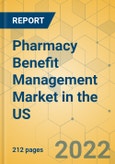Speak directly to the analyst to clarify any post sales queries you may have.
The U.S. pharmacy benefit management market is expected to grow at a CAGR of 5.53% during 2022-2027
MARKET INSIGHTS
The PBM industry refers to companies that act as intermediaries between insurance companies, pharmacies, and pharmaceutical companies. PBM is responsible for reducing insurers and their drug costs. They achieve this by negotiating with pharmacies and pharmaceutical companies. The pharmacy benefit management systems entered the pharmaceutical industry in the 1960s to meet the needs of employer-based health benefits. They soon became an important stakeholder in the entire pharmaceutical supply chain.
Pharmacy costs represent almost 32% of the total health care spending, and this expenditure is expected to grow more than two times during the forecast period. Currently, pharmacy benefit management plays a major role and acts as an intermediary between payers, drug manufacturers, and pharmacies.
Since PBMs play a significant role in influencing out-of-pocket costs and patient access to medications owing to their management tools, formulary power, and price concessions. They are in a position of power to pass savings to customers. According to PBM lobby groups, between 2020 to 2029, PBM tools will reduce consumer and plan sponsors' spending by more than $1 trillion.
There is a growing criticism of PBMs with claims that they are driving up costs of drug prices, making huge gains via pharmacy spreads, rebates from manufacturers, and fees from the supply chain. This is being spurred by the opaqueness of the true cost of drugs to PBMs owing to the rules of engagement between manufacturers and PBMs.
The future of PBMs is going to be dictated by the implementation of state and national-level policies in terms of their revenue streams and business practices in the pharmaceutical space.
U.S. Pharmacy Benefit Management Market Segmentations
- Based on services, specialty pharmacy services are the major contributor in the pharmacy benefit management market in the US, and it is likely to witness high incremental growth of $48.24 billion during the forecast period.
- Based on health plans, commercial health plans are the major contributor in the pharmacy benefit management market in the US, and it is likely to witness high absolute growth of 34.69% during the forecast period.
Segmentation by Health Plan
- Commercial Health Plans
- Medicare
- Medicaid
- Others
Segmentation by Services
- Specialty Pharmacy Services
- Retail Pharmacy Networks
- Mail-Order Pharmacy Services
- Claims Processing
- Formulary Management
- Drug Utilization Review
- Price, Discount, & Rebate Negotiations
- Disease Management & Adherence Initiatives
Segmentation by Business Model
- Insurance Companies and Retail Pharmacies
- Pure Play PBMS
VENDOR ANALYSIS
The presence of prominent market players, increasing favorable healthcare reforms, rising e-prescription, and growing adoption of healthcare plans by us residents are the primary factors for the significant market share in the country.
Key Company Profiles
- CVS Health
- Cigna
- UnitedHealth Group
Key Companies to Watch
- Humana Pharmacy Solutions
- Medimpact
- Prime Therapeutics
Other Prominent Vendors
- Abarca Health
- AscellaHealth
- BeneCard PBF
- CaptureRx
- Centene
- Change Healthcare
- Citizens Rx
- EnvisionRxOptions
- Excelera
- Magellan Rx Management
- MedalistRx
- MaxorPlus
- Navitus Health Solutions
- PerformRx
- ProCare Rx
- RxAdvance
- Rite Aid
- WellDyneRx
- Walgreens Boots Alliance
Table of Contents
Companies Mentioned
- CVS Health
- Cigna
- UnitedHealth Group
- Humana Pharmacy Solutions
- Medimpact
- Prime Therapeutics
- Abarca Health
- AscellaHealth
- BeneCard PBF
- CaptureRx
- Centene
- Change Healthcare
- Citizens Rx
- EnvisionRxOptions
- Excelera
- Magellan Rx Management
- MedalistRx
- MaxorPlus
- Navitus Health Solutions
- PerformRx
- ProCare Rx
- RxAdvance
- Rite Aid
- WellDyneRx
- Walgreens Boots Alliance
Methodology
Our research comprises a mix of primary and secondary research. The secondary research sources that are typically referred to include, but are not limited to, company websites, annual reports, financial reports, company pipeline charts, broker reports, investor presentations and SEC filings, journals and conferences, internal proprietary databases, news articles, press releases, and webcasts specific to the companies operating in any given market.
Primary research involves email interactions with the industry participants across major geographies. The participants who typically take part in such a process include, but are not limited to, CEOs, VPs, business development managers, market intelligence managers, and national sales managers. We primarily rely on internal research work and internal databases that we have populated over the years. We cross-verify our secondary research findings with the primary respondents participating in the study.

LOADING...








